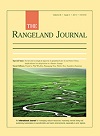
The Rangeland Journal
Volume 36 Number 6 2014
Social and Ecological Aspects of Grassland Use in Northern China: Implications for Adaptation to Climate Change
RJ14054Climate changes during the past 31 years and their contribution to the changes in the productivity of rangeland vegetation in the Inner Mongolian typical steppe
RJ14054 Abstract | RJ14054 Full Text | RJ14054PDF (352 KB) Open Access Article
RJ14065Response of the annual biomass production of a typical steppe plant community to precipitation fluctuations
The effects of precipitation fluctuations on dominant species, functional groups and plant community were measured in a long-term (29 years) fenced area in a typical steppe region in northern China. The amount of annual precipitation affected the annual biomass of the dominant species and consequently the aboveground net primary productivity (ANPP). A positive linear relationship was found between annual precipitation and the biomass of perennial grasses, perennial forbs and Stipa grandis. The ANPP increased linearly with increasing amount of annual precipitation.
RJ14065 Abstract | RJ14065 Full Text | RJ14065PDF (374 KB) Open Access Article
RJ13051Evaluation of the livelihood vulnerability of pastoral households in Northern China to natural disasters and climate change
The vulnerability to disasters and climate change of the herders in the grassland areas of Northern China were evaluated in this study. The results showed that the livelihoods of herders in the west of this area are more vulnerable than those in the east. The key reason is that the more vulnerable herders own fewer natural resources, including grassland areas and livestock.
RJ13051 Abstract | RJ13051 Full Text | RJ13051PDF (452 KB) Open Access Article
RJ14011Assessment of vulnerability to climate change in the Inner Mongolia steppe at a county scale from 1980 to 2009
Based on the Pressure-State-Response model, a vulnerability assessment to climate change framework of counties in Inner Mongolia was built, which included three layers and 17 indicators. Climate change vulnerability of eight counties in the steppe area of Inner Mongolia was assessed from 1980 to 2009. The results showed that in the past 30 years, climate change vulnerability of eight counties has decreased trend with the decrease more pronounced after 2000. But, overall, the vulnerability of the Inner Mongolia steppe remains high. Most of the counties are moderately vulnerable; some counties are seriously vulnerable, even extremely vulnerable.
RJ14011 Abstract | RJ14011 Full Text | RJ14011PDF (764 KB) Open Access Article
RJ14048Herders’ perception of climate change does not always fit with actual climate change
Herders’ perception did not agree with the actual climate changes in six rangeland regions of Inner Mongolia in northern China. The majority of herders perceived a decline in precipitation over the past 30 years, whereas actual data showed no significant change. Furthermore, herders’ perceptions of a decrease in rainfall appeared to be influenced by their perceptions of reductions in the productivity of their rangelands.
RJ14048 Abstract | RJ14048 Full Text | RJ14048PDF (433 KB) Open Access Article
RJ13050Grazing primarily drives the relative abundance change of C4 plants in the typical steppe grasslands across households at a regional scale
Understanding the effects of climate change and grazing on the relative abundance of C4 plants in steppe grasslands is important. A 5-year experiment in the typical steppe region of Inner Mongolia showed that both increasing temperature and grazing intensity promoted the relative abundance of C4 plants, and grazing was the primary driver. This study provides a basis for assessing the effects of climate and land-use change on grassland ecosystem structure and function.
RJ13050 Abstract | RJ13050 Full Text | RJ13050PDF (667 KB) Open Access Article
RJ13038The response of grassland productivity, soil carbon content and soil respiration rates to different grazing regimes in a desert steppe in northern China
The effects of continuous, rotational and absence of grazing were measured on several community attributes in 2010 and 2012 on a desert steppe in northern China. Soil respiration increased linearly with increasing aboveground net primary productivity, belowground net primary productivity, and soil carbon and nitrogen contents across the 2 years, whereas a negative correlation was detected between soil respiration and soil temperature. The community aboveground net primary productivity, belowground net primary productivity, litter mass, soil carbon and nitrogen contents and soil respiration rates were lower in a dry year (2010) than in a wet year (2012).
RJ13038 Abstract | RJ13038 Full Text | RJ13038PDF (493 KB) Open Access Article
RJ13115Different responses of plant species to deferment of sheep grazing in a desert steppe of Inner Mongolia, China
RJ13115 Abstract | RJ13115 Full Text | RJ13115PDF (521 KB) Open Access Article
RJ13088Effects of mowing regimes and climate variability on hay production of Leymus chinensis (Trin.) Tzvelev grassland in northern China
Haymaking is an important practice for preparing winter feed for livestock production in northern China. Effects of four mowing regimes and climate variability on hay production in a Leymus chinensis natural grassland were investigated over 27 years. The results suggest that the best haymaking practice should be based on the rule of ‘mowing once a year’ in high-production years and grazing in low-production years.
RJ13088 Abstract | RJ13088 Full Text | RJ13088PDF (437 KB) Open Access Article
RJ13040Herders’ opinions about desirable stocking rates and overstocking in the rangelands of northern China
The Chinese government has proposed the ‘balancing animals and grass’ policy to remediate grassland degradation; but herders’ perceptions about desirable stocking rates are different from the policy standard. Herders have their own particular ‘desirable stocking rates’ and different herders from different rangeland regions have different desirable stocking rates. Those herders with more formal education and those who worked in a village council and had smaller areas of rangelands, were more concerned about the overstocking of rangelands.
RJ13040 Abstract | RJ13040 Full Text | RJ13040PDF (378 KB) Open Access Article



